写真資料は小坂文乃氏提供
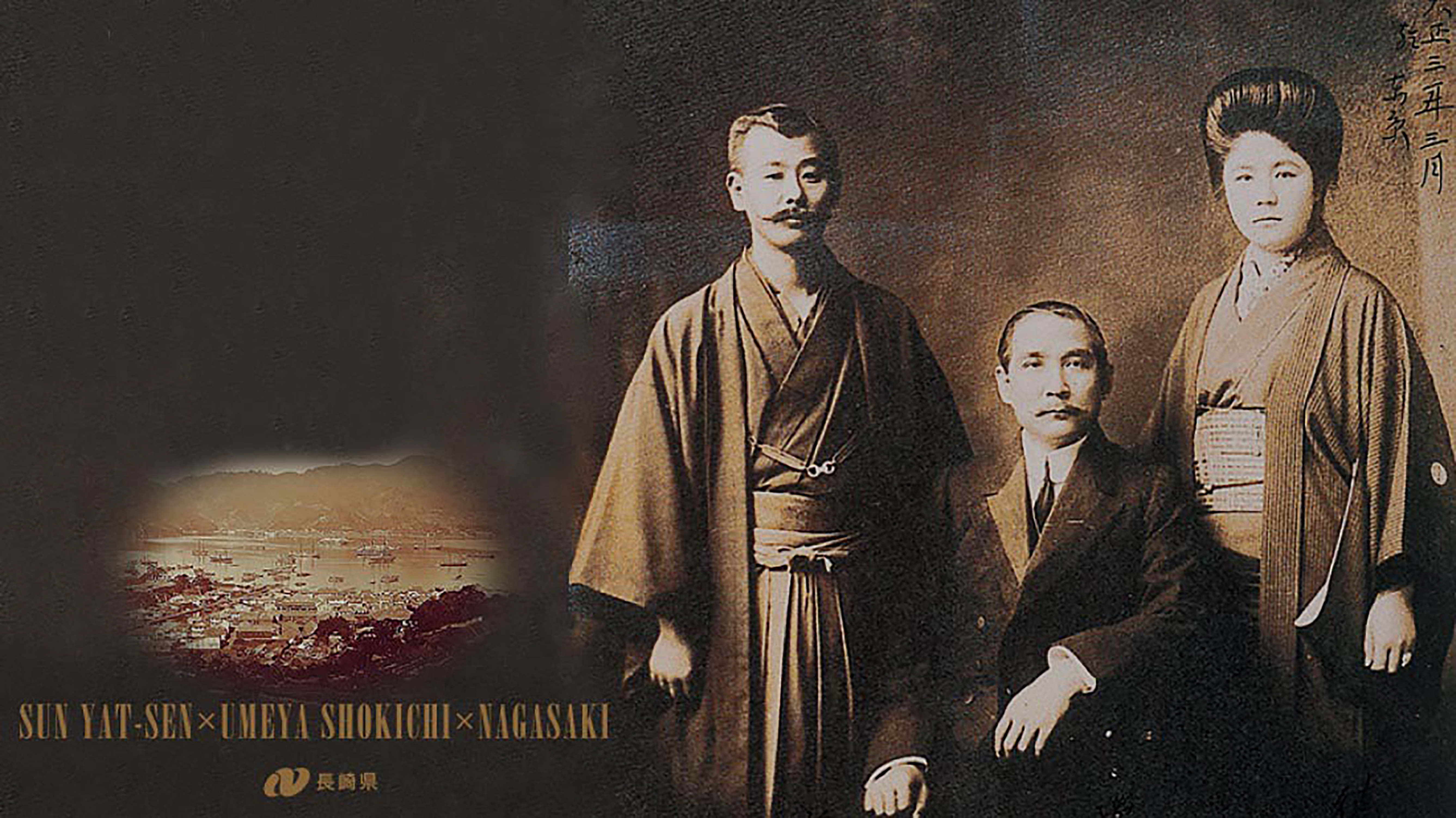
孫文・梅屋庄吉と長崎
Sun Yat-sen, Umeya Shokichi and Nagasaki
孫文を支えた男 梅屋庄吉
トクと宋慶齢
The Man Behind Sun Yat-sen: Umeya Shokichi
Umeya Toku and Soong Ching-ling
秘められたエピソード
-
梅屋庄吉の名は、これまで映画史に残るのみであり、孫文との友情は秘話として隠されてきました。
辛亥革命100周年を迎えた2011年(平成23年)、革命を導いた孫文を支えたひとりの日本人梅屋庄吉が大きく紹介されました。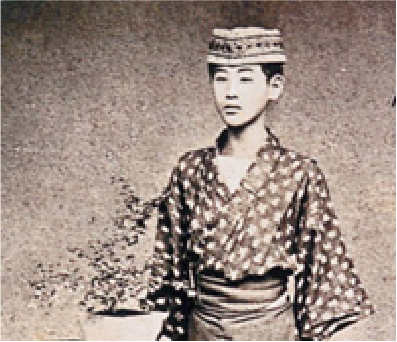
10歳頃の庄吉

左:梅屋庄吉 右:孫文
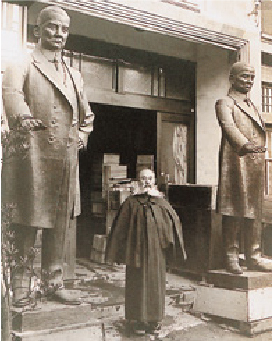
完成した銅像と庄吉
長崎で育つ
-
梅屋庄吉は1868 年(明治元)、長崎に生まれました。長崎は歴史的に中国と結びつきが強く、また、鎖国時代を通じて西洋への窓口であったことから、最先端の知識や技術を学ぶことができる街でした。こうした長崎の風土が梅屋庄吉の卓越した国際感覚や時代を先取りした先鋭的な物の見方をはぐくみました。
二人の出会い
-
孫文と梅屋庄吉。二人は香港の地で共通の知人である英国人医師ジェームス・カントリー博士を通じて出会ったといいます。このとき、孫文29 歳、梅屋庄吉27 歳。若き日に誓いあった友情は、生涯続くことになります。
守られた誓い
-
孫文の革命にかける情熱を知り「君は兵を挙げたまえ、我は財を挙げて支援す」という盟約を結んだ梅屋庄吉。海外生活を経て日本に戻った後には映画興行で莫大な財をなし、若き日の誓いを守って生涯にわたり莫大な支援を行いました。彼は一生をかけて、物心両面から孫文を支え続けたのです。こうして孫文は辛亥革命を成功に導きました。
最後の大事業となった銅像制作
-
1925年(大正14)、孫文は逝去しました。梅屋庄吉は失意を振り払うかのように孫文の業績を後世に伝えるという志の実現に動き出します。財産をつぎ込み、現在の価格で1億5千万円にのぼる費用をかけて孫文の銅像4体を制作し、中国に寄贈しました。孫文像は中国でも歓迎され、現在でも広州、南京、マカオの各地で大切にされています。
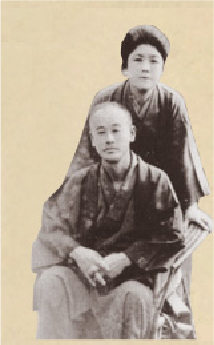
梅屋庄吉
1868 年( 明治元) 長崎に生まれる。
現在の日活株式会社の前身である日本活動写真株式会社の創立者の一人。
1934 年( 昭和9) 65 歳で死去。孫文
1866 年中国の現・中山市に生まれる。
中国における革命運動の指導者であり、辛亥革命によって建国された中華民国の臨時大総統。
1925 年、58 歳で死去。
梅屋庄吉とトクの結婚
-
タイで事業を興すことを目指し東京と香港を行き来していた梅屋庄吉は、1894年(明治27)、2年ぶりに長崎に立ち寄り、一人の女性と出会います。この女性は、両親が梅屋家に養女として迎えたトクでした。祝言を挙げた二人でしたが、梅屋庄吉が再び海外に赴いてからの9年間、トクは長崎に残って梅屋商店を切り盛りしました。
仲人役をつとめたトク
-
孫文は日本亡命中の1915年(大正4)、宋慶齢と結婚します。
梅屋庄吉の妻トクは、宋慶齢が日本から中国へ帰国した後、意気消沈する孫文の様子から宋慶齢に対する愛情が本物であることを見抜き、結婚のお膳立てをしました。結婚披露宴は東京の梅屋家で催され、その後もトクは細やかな世話で二人の生活を支えました。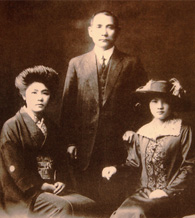
孫文夫妻とトク
孫文の妻 宋慶齢
-
こうした経緯から、トクと宋慶齢という二人の妻の間にも、夫同様の強い絆が結ばれました。戦後、宋慶齢は中国政府の要人となり、慈善活動などの功績が認められ、「中国の良心」とまで呼ばれるようになりますが、彼女の梅屋夫妻に対する心からの感謝の気持ちが消えることはありませんでした。
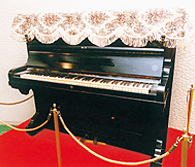
宋慶齢が愛用したピアノ
梅屋家と宋慶齢の絆
-
「梅屋さんの娘が生きていたら会いたい。元気なうちに会いたい。」宋慶齢がそう言って梅屋夫妻の娘千世子に招待状を送ったのは1975年(昭和50)。3年後、千世子の訪中が叶って再会を果たします。千世子が記念に贈った写真に対する宋慶齢からの返礼の手紙には、「夫婦2組の友情を消せるものはない」という力強い言葉が記されていました。
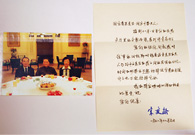
再会の写真と宋慶齢からの礼状
梅屋トク
1875年(明治8) 壱岐島の可須村(現・長崎県壱岐市勝本町)の士族香椎家に次女として生まれる。
1894年(明治27) 庄吉と結婚。
1947年(昭和22) 71歳で死去。宋慶齢
1893年中国の上海に宋家の次女として生まれる。
14歳でアメリカに留学。1915年孫文と結婚。
1981年88歳で死去する約2週間前に名誉国家主席の称号を得ている。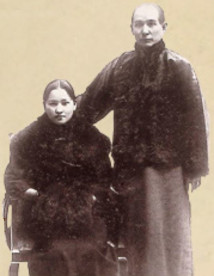
Hidden episodes
-
Umeya Shokichi’s name has been found only in film history, and his friendship with Sun Yat-sen has been hidden as a secret story.
In 2011, which marked the 100th anniversary of the Xinhai Revolution, Umeya Shokichi was widely introduced as a Japanese who supported the revolutionary leader Sun Yat-sen.
Shokichi, around 10 years old

Left: Umeya Shokichi, Right: Sun Yat-sen

Shokichi with completed bronze statues
Brought up in Nagasaki
-
Umeya Shokichi was born in Nagasaki in 1868. Historically, Nagasaki has had close ties with China and was a window to the West throughout Japan’s period of national isolation (1639–1854), making it a place where one could learn cutting-edge knowledge and technology. These regional characteristics of Nagasaki fostered his outstanding international vision and radical perspective on things that was ahead of the times.
How they met
-
Sun Yat-sen and Umeya Shokichi met in Hong Kong through a mutual acquaintance, Sir James Cantlie, a British physician. At this time, Sun was 29 and Umeya was 27. The friendship they pledged in their youth lasted a lifetime.
Pledge kept
-
Umeya Shokichi, knowing Sun Yat-sen’s passion for the revolution, made a pledge: “You raise your army, and I will raise my money to support you.” Returning to Japan after living abroad, he made a huge amount of money in the film business, kept his youthful pledge, and provided Sun with tremendous support over his lifetime. He continued to support Sun materially and spiritually throughout his life. This enabled Sun to lead the Xinhai Revolution to success.
Creation of bronze statues, the last major project
-
Sun Yat-sen passed away in 1925. As if to shake off his disappointment, Umeya Shokichi set about realizing his ambition to pass on Sun’s achievements to future generations. He spent most of his fortune on creating four bronze statues of Sun, costing 150 million yen in today’s value, and donated them to China. The statues were welcomed in China and are still treasured in Guangzhou, Nanking, and Macau.

Umeya Shokichi
Born in Nagasaki in 1868.
One of the founders of Nippon Katsudo Shashin Corporation, the predecessor of the current Nikkatsu Corporation.
Passed away in 1934 at the age of 65.Sun Yat-sen
Born in 1866 in present-day Zhongshan City, China.
Leader of the revolutionary movement in China and Provisional President of the Republic of China, which was established by the Xinhai Revolution.
Passed away in 1925 at the age of 58.
Marriage of Umeya Shokichi and Toku
-
In 1894, while traveling between Tokyo and Hong Kong to start a business in Thailand, Umeya Shokichi stopped in at Nagasaki for the first time in two years and met a woman there. She was Toku, whom his parents had adopted into the Umeya family. They married, but for nine years after Shokichi went overseas again, Toku remained in Nagasaki to run the family business, Umeya Shoten.
Toku serving as matchmaker
-
Sun Yat-sen married Soong Ching-ling in 1915 while in exile in Japan.
Sometime before their marriage, after Soong returned to China from Japan, Toku, the wife of Umeya Shokichi, saw Sun’s depressed state and realized that his love for Soong was real. So she arranged their marriage. The wedding reception was held at Umeya’s house in Tokyo, and Toku continued to support the couple’s life with meticulous care.
Sun Yat-sen and Toku
Soong Ching-ling, the wife of Sun Yat-sen
-
Through these circumstances, the two wives, Umeya Toku and Soong Ching-ling, formed a bond as strong as that of their husbands. After World War II, Soong became a key figure in the Chinese government and was even called the “Conscience of China” for her charitable activities and other achievements. All this time, her heartfelt gratitude to Mr. and Mrs. Umeya never disappeared.

Piano used by Soong Ching-ling
The bond between the Umeya family and Soong Ching-ling
-
In 1975, Soong Ching-ling said, “If Mr. and Mrs. Umeya’s daughter is alive, I would like to see her while I am still healthy,” and sent an invitation to their daughter Chiseko. Three years later, Chiseko was able to visit China and they met again. Upon receiving a commemorative photo from Chiseko, Soong wrote a letter in return. It contained the powerful words, “Nothing can erase the friendship between the two couples.”

Reunion photo and thank-you letter from Soong Ching-ling
Umeya Toku
Born in 1875 as the second daughter of the Kashii family, a family with samurai ancestry, in Kasu Village on Iki Island (present-day Katsumoto-cho, Iki City, Nagasaki Prefecture).
Married Umeya Shokichi in 1894.
Passed away in 1947 at the age of 71.Soong Ching-ling
Born in 1893 as the second daughter of the Soong family in Shanghai, China.
Studied in the United States at the age of 14. Married Sun Yat-sen in 1915.
Passed away in 1981 at the age of 88, about two weeks after receiving the title of Honorary Chairwoman of the People’s Republic of China.
Photographic materials have been provided by Ms. Kosaka Ayano.









